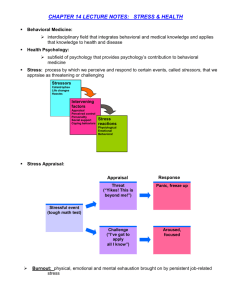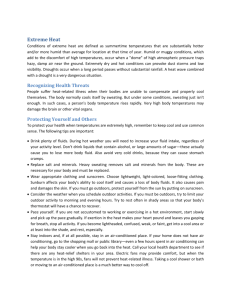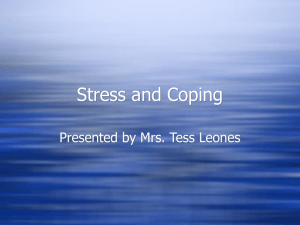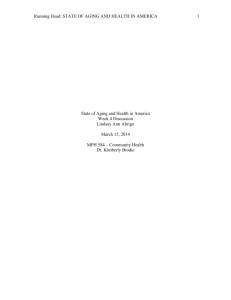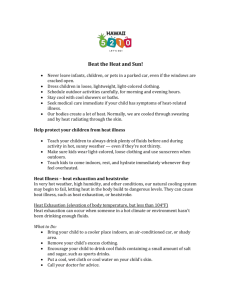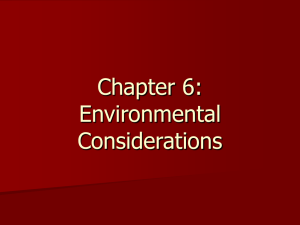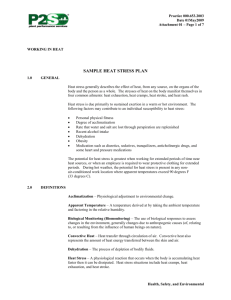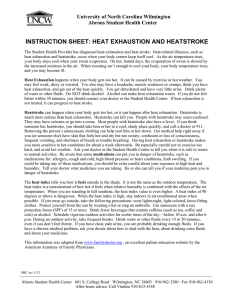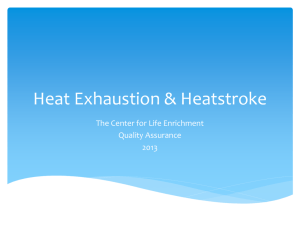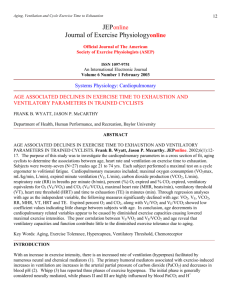Extreme Heat Alert for Older Adults
advertisement
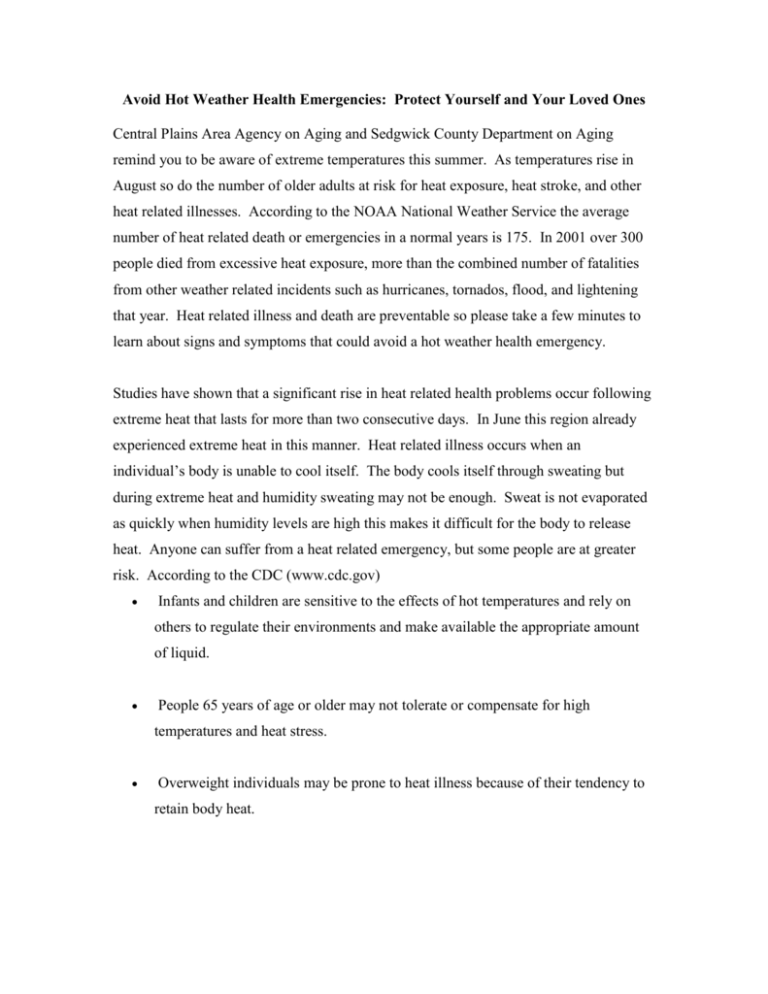
Avoid Hot Weather Health Emergencies: Protect Yourself and Your Loved Ones Central Plains Area Agency on Aging and Sedgwick County Department on Aging remind you to be aware of extreme temperatures this summer. As temperatures rise in August so do the number of older adults at risk for heat exposure, heat stroke, and other heat related illnesses. According to the NOAA National Weather Service the average number of heat related death or emergencies in a normal years is 175. In 2001 over 300 people died from excessive heat exposure, more than the combined number of fatalities from other weather related incidents such as hurricanes, tornados, flood, and lightening that year. Heat related illness and death are preventable so please take a few minutes to learn about signs and symptoms that could avoid a hot weather health emergency. Studies have shown that a significant rise in heat related health problems occur following extreme heat that lasts for more than two consecutive days. In June this region already experienced extreme heat in this manner. Heat related illness occurs when an individual’s body is unable to cool itself. The body cools itself through sweating but during extreme heat and humidity sweating may not be enough. Sweat is not evaporated as quickly when humidity levels are high this makes it difficult for the body to release heat. Anyone can suffer from a heat related emergency, but some people are at greater risk. According to the CDC (www.cdc.gov) Infants and children are sensitive to the effects of hot temperatures and rely on others to regulate their environments and make available the appropriate amount of liquid. People 65 years of age or older may not tolerate or compensate for high temperatures and heat stress. Overweight individuals may be prone to heat illness because of their tendency to retain body heat. People who overexert during work, play or exercise may become dehydrated and vulnerable to heat sickness. People who have physical illnesses, especially with heart disease or high blood pressure, medications for depression, insomnia, or poor circulation, may be affected by extreme heat. Visit adults at risk at least twice a day and closely watch them for signs of heat exhaustion or heat stroke. Infants and young children, of course, need much more frequent watching. According to the CDC, adults 65 and older do not adjust as well as young people to sudden changes in heat. They are more likely to have medical conditions such as high blood pressure, poor circulation and heart disease that can upset the normal body response to high temperatures. They are also more likely to take prescriptions that impair the body’s ability to regulate temperature or ability to perspire. An older person may have an increased risk of heat related illness if they are living alone or have no assistance from family or friends. The use of air-conditioning is the number one protective factor against heat-related emergencies and death. With today’s high cost of food and gas, financial constraints may prevent many seniors from using or repairing their air conditioner or fans. Fear of crime may also prevent some from opening windows and doors. During these hot summer months Sedgwick County Department on Aging and Central Plains Area Agency on Aging encourage older adults to stay out of the extreme heat and take advantage of free programs at local senior centers, senior dining centers, public library or volunteer for a non-profit agency. These are excellent options to beat the heat, connect with the community, and support community organizations. Becoming familiar with the warning signs of heat related illness will help older adults in your family and in your neighborhood. According to the Centers for Disease Control and Prevention, warning signs of heat exhaustion include the following: Heavy sweating Paleness Muscle cramps Tiredness Weakness Dizziness Headache Nausea or vomiting Fainting The CDC stresses that “if heat exhaustion is untreated, it may progress to heat stroke. Seek medical attention immediately if any of the following occurs: symptoms are severe or the victim has heart problems or high blood pressure Symptoms are severe The victim has heart problems or high blood pressure Otherwise, help the victim to cool off, and seek medical attention if symptoms worsen or last longer than 1 hour.” The best defense is prevention. Here are some tips from the CDC on preventing and managing heat: Do not engage in strenuous activity Drink more fluids regardless of your activity level. Avoid drinks that include caffeine, alcohol, or large amounts of sugar. Stay in doors. – (public library, mall, used bookstore) even a few hours can assist your body to remain cooler. Electric fans will help but when the heat is in the 90s, fans are not extremely helpful. Taking a cool shower or bath or finding an air-conditioned location will provide the body the needed relief from the heat. NEVER leave anyone in a closed, parked vehicle. Do not engage in strenuous activity During this summer’s extreme heat please take a few extra minutes to check on older adults in your life several times a day and monitor other at higher risk more closely. Also, encourage them to follow the Tips on Preventing and Managing Heat. Central Plains Area Agency on Aging is available to assist caregivers and seniors through life’s transitions with various levels of support. For information about this article or other programs for seniors and caregiver contact 316-660-5120 or visit www.cpaaa.org. Becky – Interesting data from NOAA National Weather Service if you can use it: Heat Index/Heat Disorders: Possible heat disorders for people in higher risk groups. Heat Index of 130° OR Higher: HEATSTROKE/SUNSTROKE HIGHLY HIGHER LIKELY WITH CONTINUED EXPOSURE, Heat Index of 105°- 130°: SUNSTROKE, HEAT CRAMPS OR HEAT EXHAUSTION LIKELY, AND HEATSTROKE POSSIBLE WITH PROLONGED EXPOSURE AND/OR PHYSICAL ACTIVITY. Heat Index of 90°- 105°: SUNSTROKE, HEAT CRAMPS AND HEAT EXHAUSTION POSSIBLE WITH PROLONGED EXPOSURE AND/OR PHYSICAL ACTIVITY. Heat Index of 80° - 90°: FATIGUE POSSIBLE WITH PROLONGED EXPOSURE AND/OR PHYSICAL ACTIVITY


